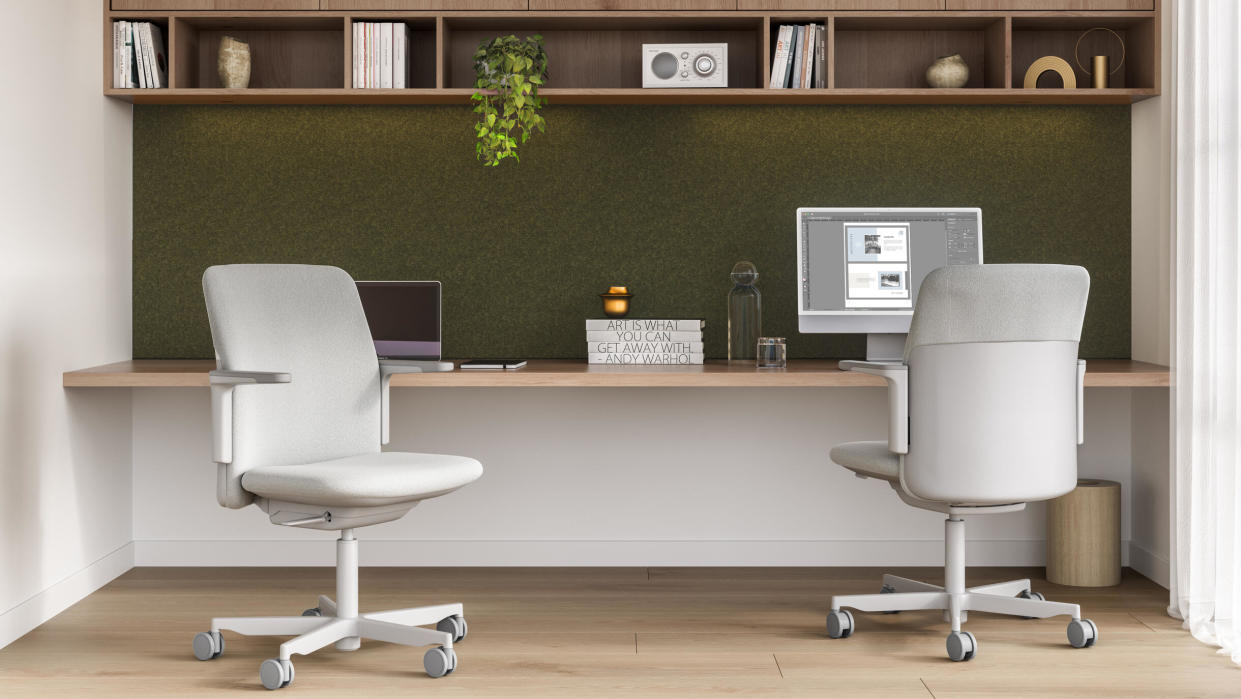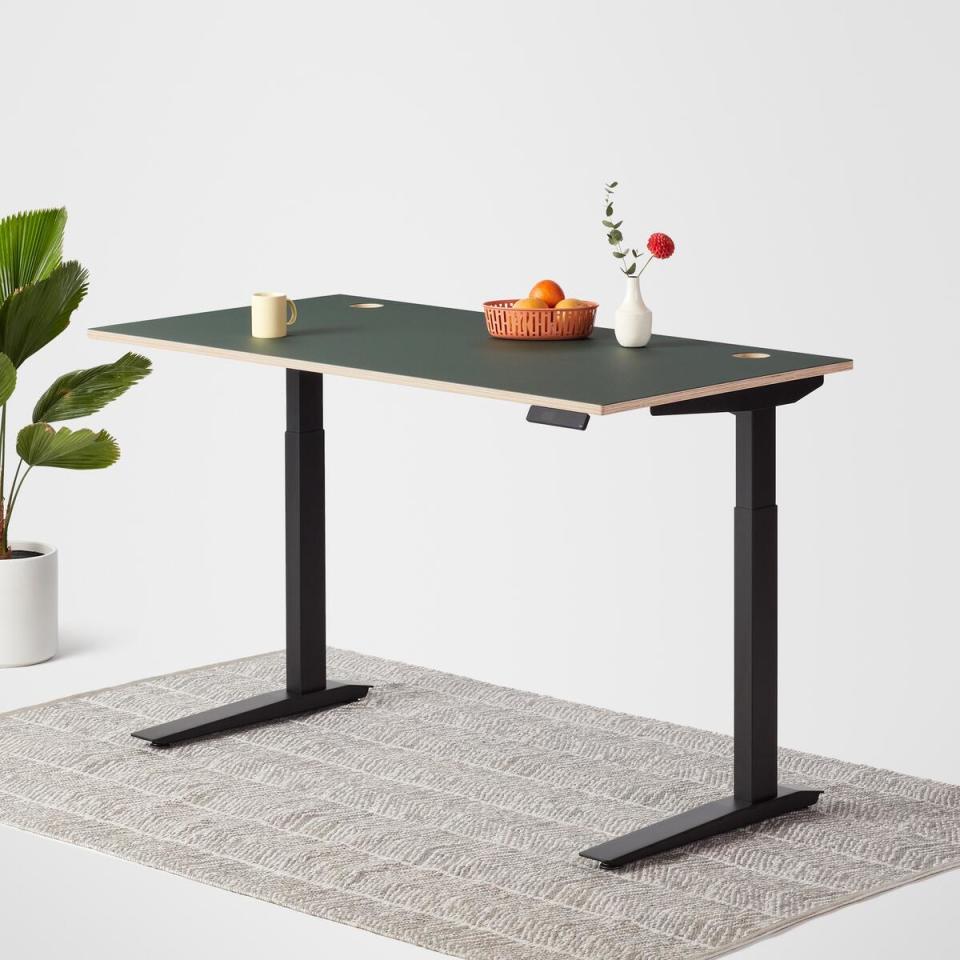How a quick ergonomics lesson can create new opportunities in the home office

on the beat | Jun 16, 2023
With a few tips on ergonomics, designers have the power to create a positive environment for the work-from-home client.
Joint disease. Herniated discs. Carpal tunnel syndrome. Many workers don’t realize it, but the office can be a hazardous workplace—and oftentimes, it all comes down to whether or not you have an ergonomic setup. In the work-from-home era, the onus increasingly falls on designers to create a space that protects their clients’ health and well-being, both on- and off-the-clock. “The most important body part to protect [while working] is the spine, and having a science-based piece of equipment to support the body is the number one priority,” says Rebecca Horton, a workplace well-being knowledge lead at Herman Miller. Not making an effort to get office ergonomics right, she says, “would be like investing in beautiful bedroom furniture and beautiful lighting, then having a really terrible mattress. You would be miserable in that space, and you would be in pain.”
The concept of ergonomics goes back hundreds of years, and our thinking about the body’s mechanics has evolved. In 1748, it was controversial when French physician and philosopher Julien Offray de LaMettrie concluded that man and machine were actually “quite similar”; it wasn’t until the 1980s that our modern understanding of ergonomics gained mainstream momentum in the furniture category with the rise of computer usage at the office. By then, experts in industrial and manufacturing environments had begun to acknowledge that certain tasks were prone to causing injury, and specialists were discovering the links between repetitive motion, awkward posture, force, vibration and injury. The biggest problem, they discovered, was that most designs to date had been entirely fixed in nature: The heights of desks, chairs and monitors were all set in one position, forcing workers to conform their bodies to the built environment. A host of postural issues were adding insult to injury—simple, mindless behaviors such as shrugging your shoulders to type, anchoring your wrists on a sharp desk edge, leaning toward your computer screen without using a chair’s backrest or situating a computer monitor too far above or below your natural viewing angle, all of which compound to create negative health effects in the long run.

While adjustable ergonomic furniture fit to solve those issues quickly started rolling off the assembly line, workers were never caught up to speed on how to utilize their new-and-improved office items. Many ergonomic chairs feature an array of overly complex knobs and controls—even when users do figure out how to work them, it’s unlikely they have knowledge of the correct physical dimensions and spatial distances necessary to optimize comfort and performance. This is still largely the case—and that’s where designers come in.
There are a few overarching guidelines to keep in mind when designing healthy workspaces: Armrests should be at equal height and level with the desk surface, and the seat height should adjust so that the top of a computer screen is positioned at or slightly below eye level. When it comes to chairs, it’s all about selecting one that supports movement—key for spinal health and reducing disk compression—through backrest tension and back lock controls. As for accessories, there are several items to avoid. According to Jonathan Puleio, a global vice president and certified professional ergonomist at Humanscale, those mouse pads with the soft, cushiony wrist anchors actually double the pressure inside your carpal tunnel nerve, which runs from palm to forearm. The little tabs on the back of many computer keyboards that change the angle at which the wrist is positioned were originally designed for beginner typists who needed to easily see the keys, not to offer wrist support—and for every 10 degrees of vertical extension, there’s a 10 percent increase in muscle activity and carpal tunnel pressure. Plus, configuring your computer monitor on a stand that places the screen above your natural line of sight can lead to bending your neck in unsupportive positions, causing pain and stiffness.
Today, ergonomics extends not just to how you sit but also how long you sit for, which can put you at risk of major long-term conditions like varicose veins or even blood clots. Too much standing, meanwhile, can lead to circulatory issues, spinal compilations and generalized fatigue. Sit-stand desks tap into the importance of finding a balance between the two positions—ideally, workers should aim to stand for 15 minutes every hour, which has the benefit of boosting metabolism and burning calories. “Our sedentary behaviors are not necessarily intentional,” says Horton. “We may begin the day thinking, ‘Today’s the day I’m taking a power walk at noon,’ but our workload often overrides our good intentions. We must make a deliberate choice to embrace the sit-to-stand lifestyle to maintain or improve our overall well-being.”
Modern technology is moving toward doing the work for us—Humanscale’s chairs feature a hidden seat pan designed to sense the user’s body weight and adjust tension controls accordingly. But until such interventions are ubiquitous, it never hurts to bring in the experts. Ergonomics professionals can advise on mock-ups, layouts and equipment choices to ensure a space is delivering comfort and performance. Or, designers can go back to school themselves: Companies like Humanscale offer a two-day certification course in office ergonomics. “The same way designers and architects meet with acoustical consultants, HVAC consultants and lighting consultants, ergonomics professionals are just one more type of consultant that can assist you, and often it can make a big difference in the overall project,” says Puleio. “It can prevent bad equipment purchases and ensure that design decisions are filtered through a lens of ergonomic research.”
This article originally appeared in Spring 2023 issue of Business of Home. Subscribe or become a BOH Insider for more.

